Most viewed
- Page Path
- HOME > Articles and issues > Most viewed
Most viewed articles are from the articles published in 2022 during the last three month.
Letter
- Tendon Rupture by Acupuncture? Reporting of Not Probable Causality Might Exaggerate Harm of Acupuncture
- Sung-A Kim, Tae-Hun Kim, Jung Won Kang
- Perspect Integr Med. 2024;3(1):63-64. Published online February 22, 2024
- DOI: https://doi.org/10.56986/pim.2024.02.010
- 15,629 View
- 15 Download
Protocols
- Systematic Review Protocol for Sham Acupuncture Validation Research
- Sung Min Lim
- Perspect Integr Med. 2023;2(2):131-133. Published online June 23, 2023
- DOI: https://doi.org/10.56986/pim.2023.06.008
- 14,529 View
- 11 Download
- 1 Citations
-
 Graphical Abstract
Graphical Abstract
 Abstract
Abstract
 PDF
PDF 
- Background
Streitberger and Park sham needles have been developed and used as non-penetrating sham acupuncture needles that can be blinded in randomized controlled clinical trials assessing the efficacy of acupuncture. Ideal sham acupuncture should not be distinguishable from an actual acupuncture treatment provided to the experimental group to ensure patient blinding; additionally, it should not have any physiological or biological effect. Providing evidence for such sophisticated sham acupuncture devices is critical, as control settings in clinical studies are based on research verifying their validity.
Methods
Three core electronic databases - PubMed, EMBASE, and the Cochrane Central Register of Controlled Trials - will be used to search for validity verification studies of sham acupuncture devices. Clinical studies that verify the validity of non-penetrating sham acupuncture devices will be included in the review.
Results
The study design, participant information, experimental and control groups, study population’s experience with acupuncture, outcome variables, and results of studies that verify the validity of sham acupuncture devices will be systematically reviewed.
Conclusion
This systematic review of validity verification studies of sham acupuncture devices is expected to help the development of more sophisticated sham acupuncture, as well as the design of studies verifying its validity in the future. -
Citations
Citations to this article as recorded by- A systematic review of sham acupuncture validation studies
Sung Min Lim, Eunji Go
BMC Complementary Medicine and Therapies.2024;[Epub] CrossRef
- A systematic review of sham acupuncture validation studies
- Validation of a New Sham Acupuncture Needle for Double-Blind Trials: A Study Protocol
- Sung Min Lim
- Perspect Integr Med. 2024;3(1):57-60. Published online February 22, 2024
- DOI: https://doi.org/10.56986/pim.2024.02.008
- 1,922 View
- 14 Download
-
 Abstract
Abstract
 PDF
PDF - Background
To establish efficacy in acupuncture treatment, rigorous randomized controlled trials (RCT) are needed. Non-invasive sham acupuncture needles are an effective tool for practitioner/participant blinding. This study presents a protocol for the validation of a newly developed sham acupuncture needle.
Methods
A double-blind RCT will be conducted on 66 healthy adults who will be randomly assigned (using computer-generated random numbers) to either the verum (n = 33) or sham (n = 33) acupuncture needle group. The needles will be inserted at 2 acupuncture points: LI4 (upper limb) and ST36 (lower limb). The primary outcome measure is the practitioner/participants belief that they received verum or sham acupuncture. The secondary outcome measures are participant-rated sensations (penetration, pain, and de qi). Adverse events will be recorded with detailed explanations, categorizing occurrences according to related or unrelated to acupuncture. As the newly developed sham acupuncture has not been studied before, an exploratory approach has been adopted. Descriptive statistics, t test, and χ² test will be applied appropriately.
Results
This study is intended to provide a protocol for the validation of a sham acupuncture needle by using a double-blind RCT setting, and the results will hopefully contribute to the standardization of the needles used for sham acupuncture. The outcomes aim to determine the reliability of practitioner/participant blinding, participant experience of sensations, and lay groundwork for a standardized control group for clinical trials in the future. The newly developed non-invasive sham acupuncture needle may reduce bias and improve reliability in the size effect of acupuncture treatment.
Review Article
- Shoulder Pain and the Potential Role of Acupuncture: A Narrative Review of Clinical Practice and Treatment Guidelines
- Stephen Birch, Myeong Soo Lee, Tae-Hun Kim, Terje Alraek
- Perspect Integr Med. 2022;1(1):3-9. Published online September 22, 2022
- DOI: https://doi.org/10.56986/pim.2022.09.002
- 5,031 View
- 110 Download
- 3 Citations
-
 Abstract
Abstract
 PDF
PDF Supplementary Material
Supplementary Material - The potential use of acupuncture for shoulder pain of various etiologies and whether clinicians make recommendations about the use of acupuncture was examined. Shoulder pain is a common clinical problem. What is the level of evidence and how often is acupuncture recommended for shoulder pain? A manual and database (PubMed) search of review articles of related clinical trials and guidelines was performed. The evidence for effectiveness of acupuncture treatment of different types of shoulder pain was weak. However, there are some studies, with a weak to moderate level of evidence, on shoulder pain (across nine subtypes of shoulder pain). Acupuncture is safe and may be a cost-effective treatment for shoulder pain. There were 131 statements recommending the use of acupuncture for shoulder pain across 12 subtypes of shoulder pain. The most common statements were for non-specific ‘shoulder pain.’ There were 11 statements against the use of acupuncture for shoulder pain and three subtypes of shoulder pain. The level of evidence in studies of acupuncture treatment for shoulder pain is low, therefore, further research is needed. Recommendations for the use of acupuncture for shoulder pain are increasing but lag behind those for other pain problems such as low back pain.
-
Citations
Citations to this article as recorded by- “Are we there yet?” – Green shoots of progress in acupuncture implementation in healthcare
Sandro Graca, Matthias Huemer, Beverley de Valois, Bobbee Vang, Lara McClure
European Journal of Integrative Medicine.2024; 69: 102371. CrossRef - Health Care Utilization for Common Shoulder Disorders: Analysis of the 2010–2019 National Patient Sample Data from the Health Insurance Review and Assessment Service in Korea
Jin-Young Kang, Doori Kim, Huijun Kim, In-Hyuk Ha, Yoon Jae Lee
Medicina.2024; 60(5): 744. CrossRef - A Review of Key Research and Engagement in 2022
John McDonald, Sandro Graca, Claudia Citkovitz, Lisa Taylor-Swanson
Journal of Integrative and Complementary Medicine.2023; 29(8): 455. CrossRef
- “Are we there yet?” – Green shoots of progress in acupuncture implementation in healthcare
Original Article
- Acupuncture Needles and the Risk of Lymphedema After Breast Cancer Surgery: A Retrospective National Cohort Study
- Ye-Seul Lee, Yucheol Lim, Jiyoon Yeo
- Perspect Integr Med. 2024;3(1):29-36. Published online February 22, 2024
- DOI: https://doi.org/10.56986/pim.2024.02.004
- 1,866 View
- 28 Download
-
 Graphical Abstract
Graphical Abstract
 Abstract
Abstract
 PDF
PDF Supplementary Material
Supplementary Material 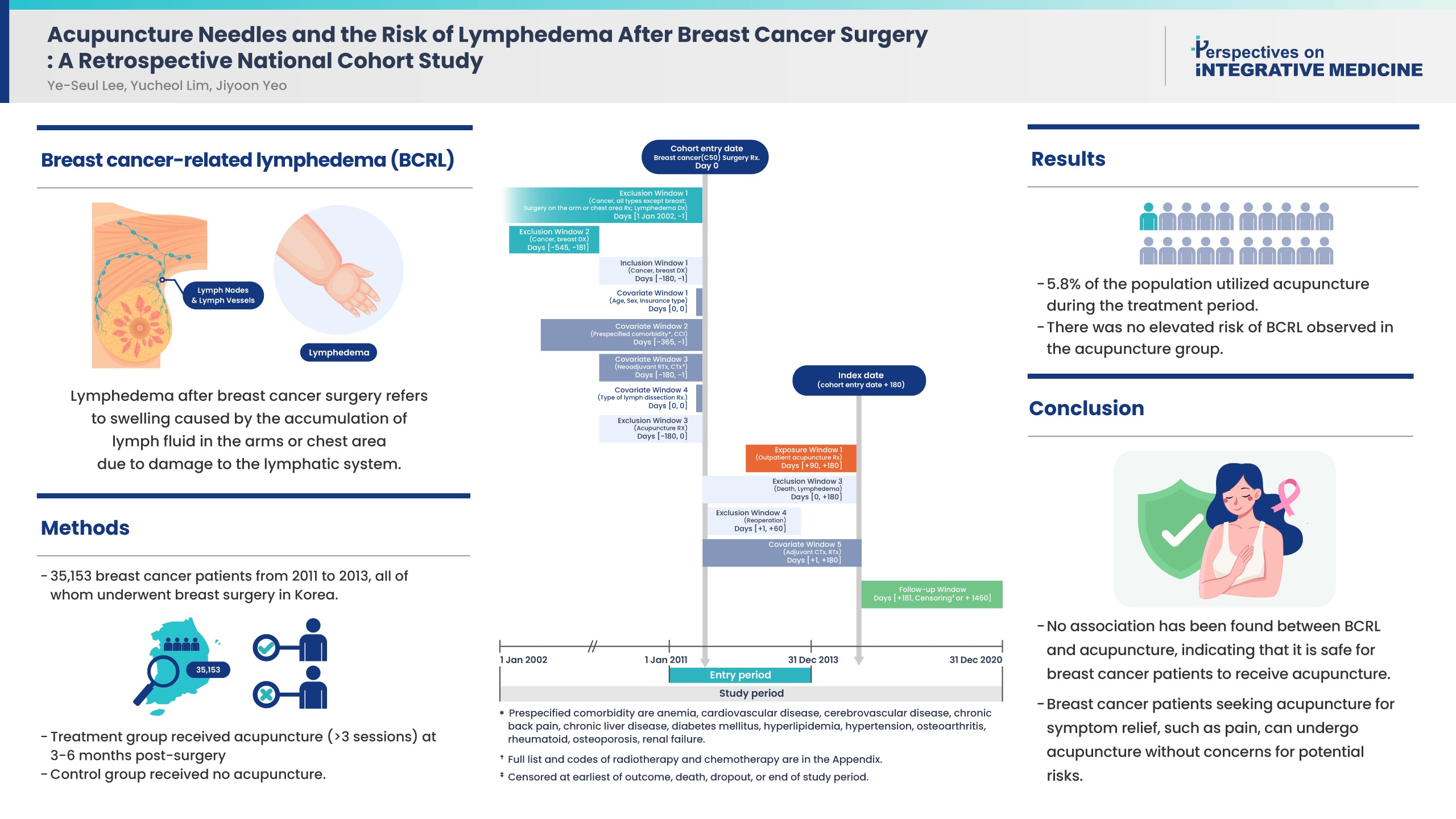
- Background
Controversies remain over the impact of using needles on breast cancer patients after surgery due to risk of breast cancer-related lymphedema (BCRL). While recent literature suggests that vascular access during the postsurgical stage does not affect the risk of BCRL, the impact of acupuncture on the risk of BCRL during the postsurgical stage has not been studied.
Methods
This study included 35,153 patients from 2011 to 2013 who were newly diagnosed with breast cancer in a population-based cohort from the Korean National Health Insurance Service database. All patients received breast surgery, and the treatment group received acupuncture for more than 3 sessions in the 3-6 months post-surgery. The control group did not receive acupuncture. The incidence rate ratio, Kaplan-Meier curve, and Cox proportional hazards models were used to compare the risk of BCRL, and death between groups.
Results
About 5.8% of the study population received acupuncture during the 3-6 months post-surgery treatment window. After propensity score matching, the acupuncture treatment group did not show an increased risk of BCRL (IRR 1.017, 95% CI 0.868-1.193; unadjusted HR 1.018, 95% CI 0.868-1.193). This risk was robust in all multivariate Cox proportional hazards models.
Conclusion
An association of BCRL with acupuncture was not observed. Patients who received acupuncture to manage symptoms such as pain during the 3-6 months postsurgical stage did not have a higher risk of developing BCRL. Breast cancer patients who seek acupuncture to alleviate post-surgery symptoms such as pain, can receive acupuncture without concerns for potential risk of BCRL.
Review Articles
- Trends in the Development of Sham Acupuncture-Related Technologies Focused on Patents Applied for in South Korea
- Sung Min Lim
- Perspect Integr Med. 2023;2(1):36-41. Published online February 21, 2023
- DOI: https://doi.org/10.56986/pim.2023.02.005
- 2,365 View
- 22 Download
- 4 Citations
-
 Graphical Abstract
Graphical Abstract
 Abstract
Abstract
 PDF
PDF 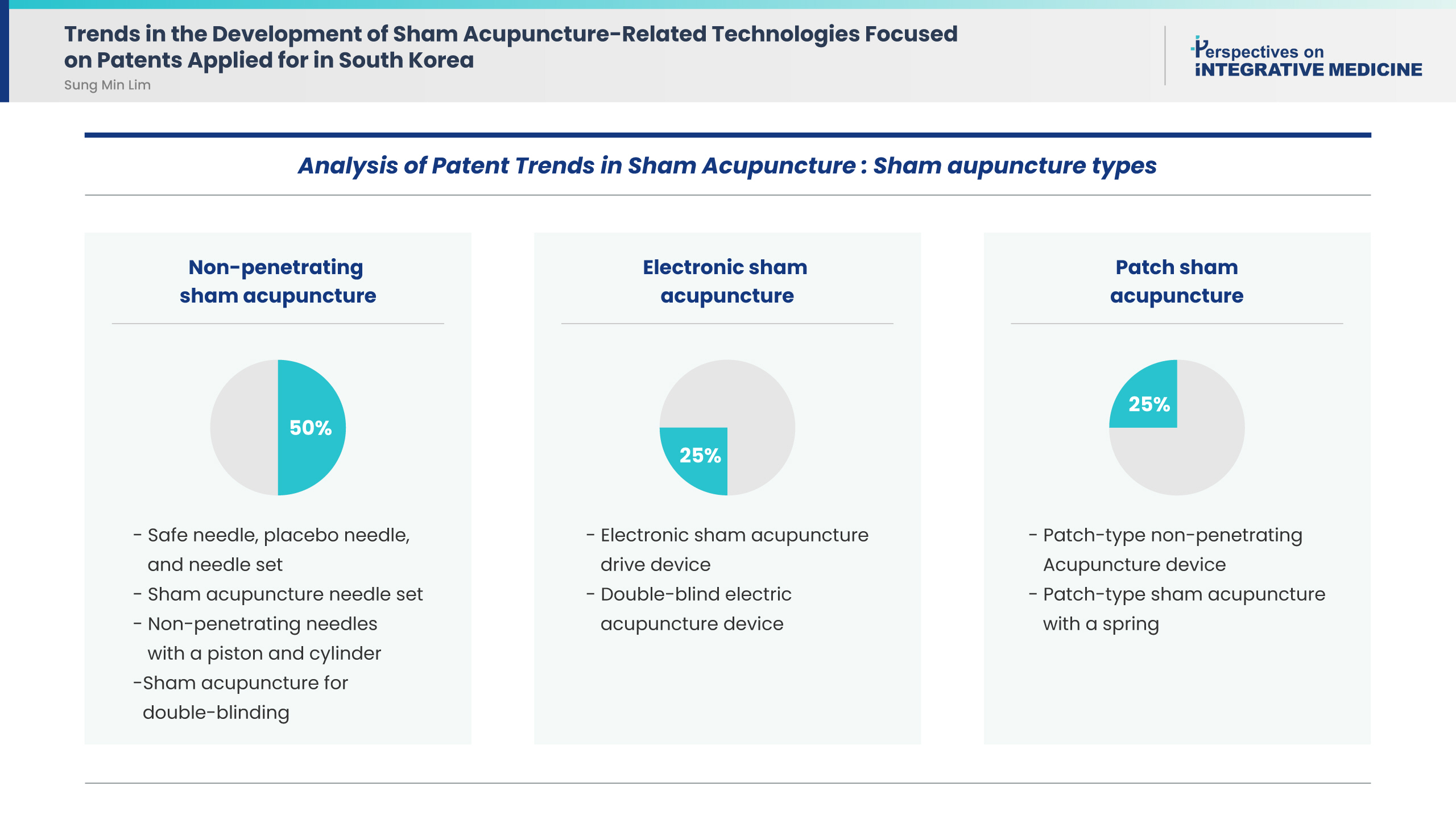
- Background
This study aimed to analyze the trends in Korean patents for sham acupuncture.
Methods
The electronic database of the Korea Intellectual Property Rights Information Service was searched for Korean patents for sham acupuncture from inception till September 2020. Patents, which were not related to sham acupuncture, were excluded. The applicant, application date, International Patent Classification, and technological content of sham acupuncture were analyzed.
Results
This study included eight patents. Application analysis identified the following sham acupuncture types: four (50%), two (25%), and two (25%) patents were for non-penetrating sham acupuncture, electronic sham acupuncture, and patch sham acupuncture, respectively. All patents aimed to use sham acupuncture as a control for rigorous double-blind clinical trials to verify the efficacy of real acupuncture treatment.
Conclusion
The present findings suggest that technological advances were focused on developing various types of sham acupuncture methods for double-blind studies. Further large-scale studies using rigorous designs are needed to investigate new sham acupuncture applications. -
Citations
Citations to this article as recorded by- Validation of a New Sham Acupuncture Needle for Double-Blind Trials: A Study Protocol
Sung Min Lim
Perspectives on Integrative Medicine.2024; 3(1): 57. CrossRef - A systematic review of sham acupuncture validation studies
Sung Min Lim, Eunji Go
BMC Complementary Medicine and Therapies.2024;[Epub] CrossRef - Trends in the Development of Acupuncture-Related Technologies Based on Patents in South Korea
Sung Min Lim, Eunji Go, Carmen Mannucci
Evidence-Based Complementary and Alternative Medic.2024; 2024: 1. CrossRef - Systematic Review Protocol for Sham Acupuncture Validation Research
Sung Min Lim
Perspectives on Integrative Medicine.2023; 2(2): 131. CrossRef
- Validation of a New Sham Acupuncture Needle for Double-Blind Trials: A Study Protocol
- A Scoping Review of Clinical Research on Motion Style Acupuncture Treatment
- Doori Kim, Yoon Jae Lee, In-Hyuk Ha
- Perspect Integr Med. 2023;2(2):65-76. Published online June 23, 2023
- DOI: https://doi.org/10.56986/pim.2023.06.001
- 2,307 View
- 45 Download
- 3 Citations
-
 Graphical Abstract
Graphical Abstract
 Abstract
Abstract
 PDF
PDF 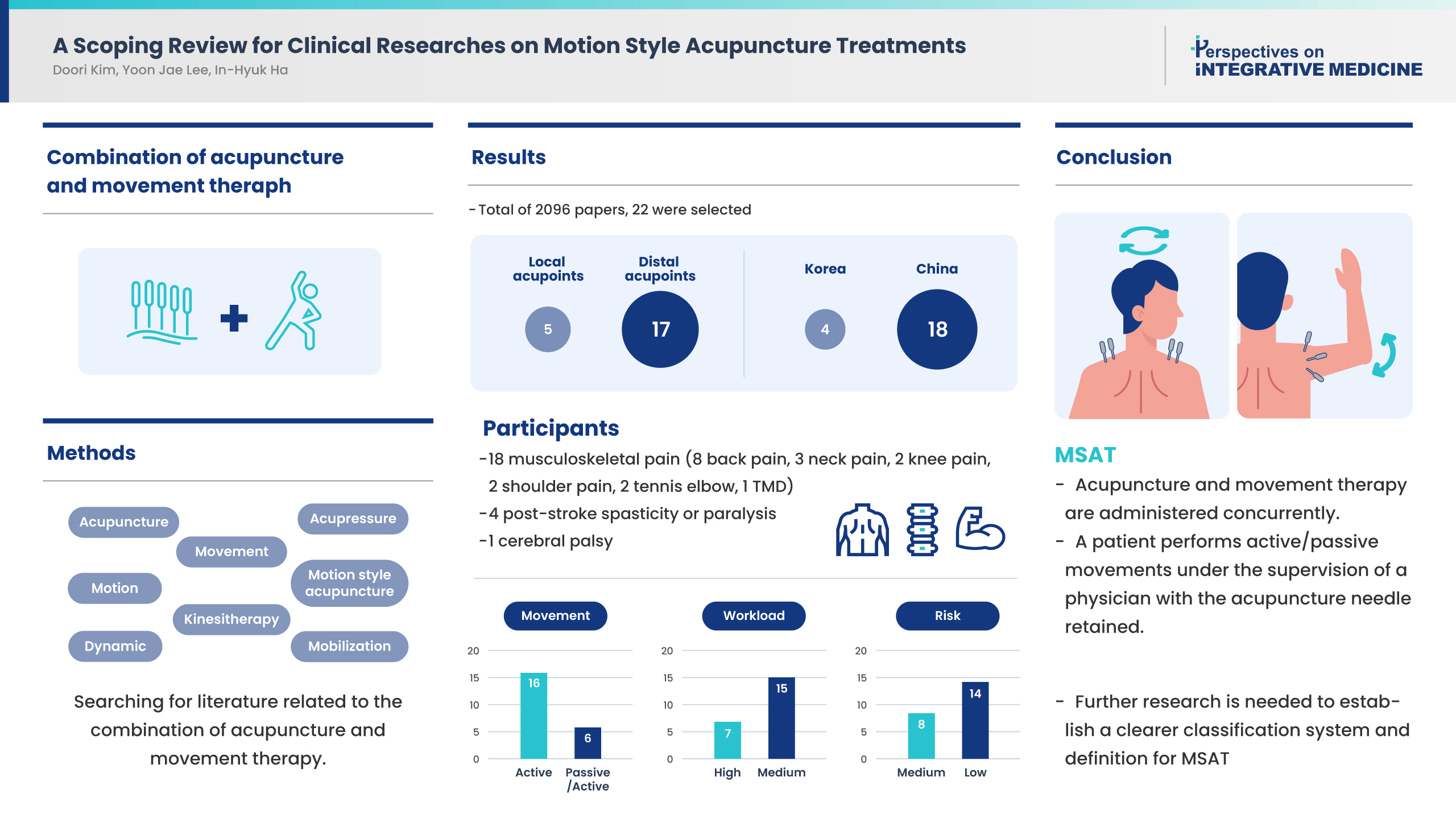
- This scoping review was conducted to examine the concept of Motion style acupuncture treatment (MSAT), use in clinical practice, its effectiveness, and safety. A literature review of clinical study treatment methods combining acupuncture and movement therapy was performed using PubMed. Of 2,096 studies retrieved, 22 were included in this review. There were 12 randomized controlled trials, and all 22 studies were published in China and Korea, mostly, within the last 3 years. There were five studies concerning local acupoints and 17 studies regarding needling at distal acupoints, and the level of risk of the procedure was “high” in eight studies and “moderate” in 14 studies. The study participants were patients with musculoskeletal pain, and many studies reported significant improvements in pain and functional disability outcomes following treatment using MSAT. For conclusion, MSAT refers to a treatment method in which a patient performs active/passive movements under the supervision of a physician with the acupuncture needle retained at the insertion site. However, there are a limited number of MSAT studies, and various treatment types and related terms are mixed. Further studies, classification of the types of MSAT using a well-established classification system, and a clearer definition of the MSAT concept are needed.
-
Citations
Citations to this article as recorded by- Effectiveness of lumbar motion style acupuncture treatment on inpatients with acute low back pain: A pragmatic, randomized controlled trial
Oh-Bin Kwon, Dong Wook Hwang, Dong-Hyeob Kang, Sang-Joon Yoo, Do-Hoon Lee, Minjin Kwon, Seon-Woo Jang, Hyun-Woo Cho, Sang Don Kim, Kyong Sun Park, Eun-San Kim, Yoon Jae Lee, Doori Kim, In-Hyuk Ha
Complementary Therapies in Medicine.2024; 82: 103035. CrossRef - Graded exercise with motion style acupuncture therapy for a patient with failed back surgery syndrome and major depressive disorder: a case report and literature review
Do-Young Kim, In-Hyuk Ha, Ju-Yeon Kim
Frontiers in Medicine.2024;[Epub] CrossRef - Effectiveness and Safety of Progressive Loading–Motion Style Acupuncture Treatment for Acute Low Back Pain after Traffic Accidents: A Randomized Controlled Trial
Seung-Yoon Hwangbo, Young-Jun Kim, Dong Guk Shin, Sang-Joon An, Hyunjin Choi, Yeonsun Lee, Yoon Jae Lee, Ju Yeon Kim, In-Hyuk Ha
Healthcare.2023; 11(22): 2939. CrossRef
- Effectiveness of lumbar motion style acupuncture treatment on inpatients with acute low back pain: A pragmatic, randomized controlled trial
Editorial
- A Pilot Trial of Integrative Medicine for Stroke Rehabilitation: Expert Recommendations for the Development and Sustainability of Integrative Medicine
- Chihyoung Son, Go-Eun Lee, Joo-Hee Seo, Inae Youn, Jin-Won Kim
- Perspect Integr Med. 2024;3(1):1-6. Published online February 22, 2024
- DOI: https://doi.org/10.56986/pim.2024.02.001
- 1,369 View
- 22 Download
-
 Graphical Abstract
Graphical Abstract
 Abstract
Abstract
 PDF
PDF 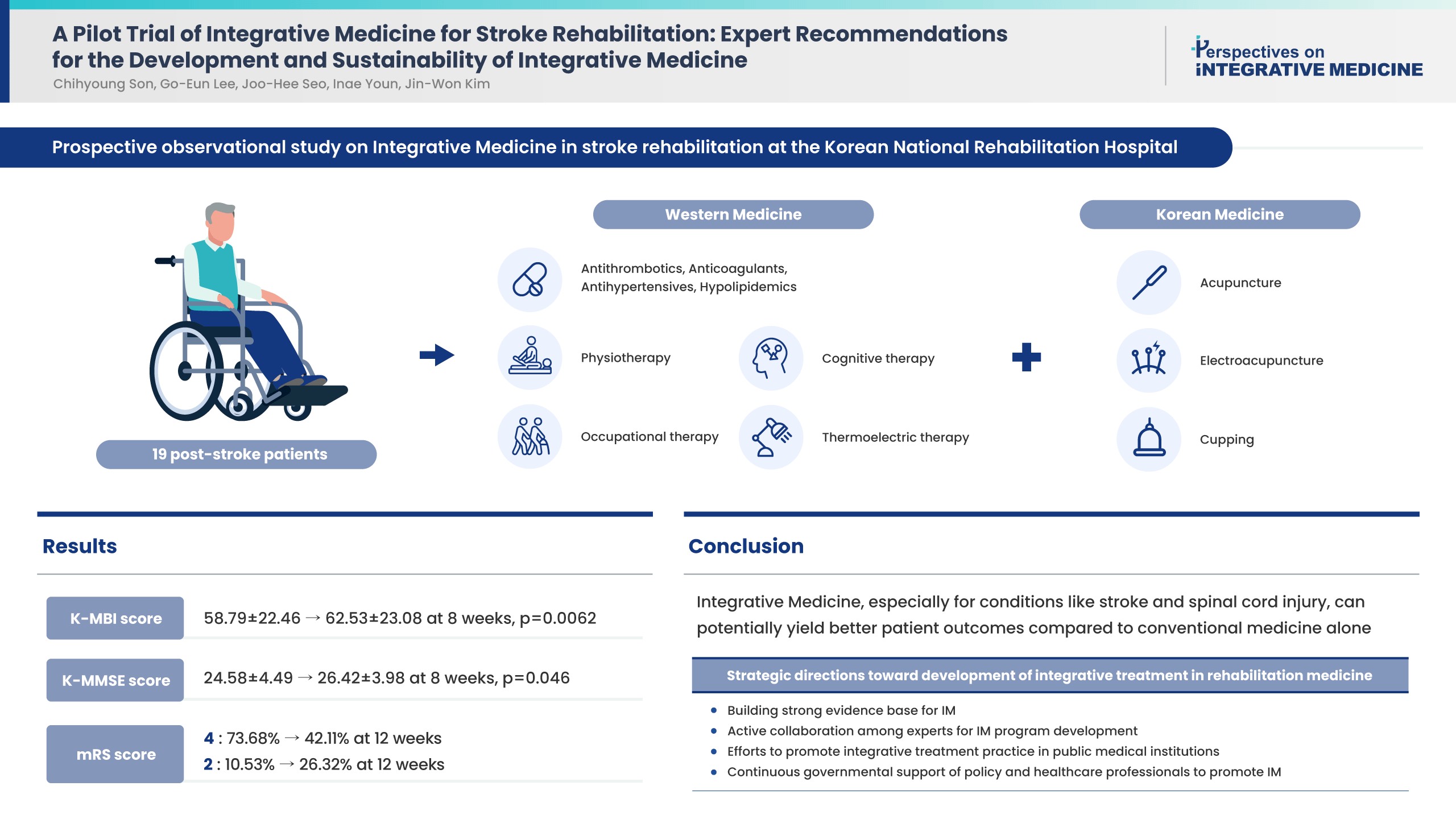
- Background
Strategies towards development and sustainability of integrative treatment in stroke rehabilitation medicine are needed. National expert recommendations based on the implementation of Integrative Medicine (IM) in stroke rehabilitation and IM outcomes would be invaluable.
Methods
A pilot study was performed and the effectiveness of combining Korean traditional medicine and Western conventional medicine in post-stroke patients (ischemic stroke n = 15 and hemorrhagic stroke n = 4) was evaluated, and recommendations were developed through consensus with physicians in national centers of rehabilitative medicine. Outcome measures [Korean Modified Barthel Index (K-MBI), Korean Mini Mental State Examination (K-MMSE), Modified Rankin Scale (mRS), and EuroQol 5-dimension 5-level (EQ-5D-5L) assessment were used at baseline, 4, 8 (K-MBI, K-MMSE, mRS, and EQ-5D-5L) and 12 weeks post treatment (EQ-5D-5L and mRS).
Results
Improvements were observed in functional and cognitive abilities at 8 weeks (K-MBI score p = 0.0062; K-MMSE score p = 0.046). Quality of life improvements (EQ-5D-5L) were observed but were not statistically significant. The disability assessment (mRS) indicated a gradual improvement from baseline to 12 weeks. No adverse events were reported. For effective, patient-centered IM treatment: (1) build a strong evidence base for IM as compared with Western medicine alone or traditional medicine alone; (2) active expert collaboration; (3) IM promotion in public medical institutions; and (4) continued government support.
Conclusion
Functional and cognitive abilities of stroke patients statistically significantly improved following 8 weeks of IM treatment. Strategies have been suggested towards the development and sustainability of IM treatment in stroke rehabilitation medicine.
Review Article
- Clinical Research on Pharmacopuncture in Korea: A Scoping Review
- Me-riong Kim, Seong Min Lee, Yoon Jae Lee, In-Hyuk Ha
- Perspect Integr Med. 2023;2(1):8-23. Published online February 21, 2023
- DOI: https://doi.org/10.56986/pim.2023.02.003
- 2,792 View
- 74 Download
- 10 Citations
-
 Graphical Abstract
Graphical Abstract
 Abstract
Abstract
 PDF
PDF Supplementary Material
Supplementary Material 
- This scoping review was performed as an update on the effects and safety of pharmacopuncture clinical research for the treatment of multiple indications in Korea. Nine electronic databases were searched to identify comparative clinical studies and clinical practice guidelines on Korean pharmacopuncture from inception to December 31, 2022. In vivo and in vitro studies, and case reports were excluded. There were 226 studies identified, including randomized controlled trials, retrospective comparison observational studies, and single-subject crossover designs, of which 17 focused on clinical safety profiles. Most studies pertained to rehabilitation medicine, especially for musculoskeletal (n = 129) and nervous system disorders (n = 35). The evidence supported treatment of neoplasms, obesity, and stroke sequelae. Adverse events of pharmacopuncture were mostly mild and temporary, and occurred more frequently with bee venom compared with herb-derived solutions. Thirty-five clinical practice guidelines including recommendations on pharmacopuncture were included. To the best of our knowledge, this is the first scoping review of clinical pharmacopuncture use in Korea, and our findings support its use in clinical practice and research. Considering the diverse clinical applications of pharmacopuncture, additional pragmatic trials are required to further strengthen the evidence base and develop standard research methodology in Korean medicine.
-
Citations
Citations to this article as recorded by- The effect of integrative Korean medicine treatment on symptomatic lumbar facet joint cysts: A case series
Hee-seung Choi, Yoon Jae Lee, Dae-Hyun Hahm, Hyangsook Lee, In-Hyuk Ha
EXPLORE.2024; 20(1): 130. CrossRef - Long-term follow-up of inpatients with meniscus tears who received integrative Korean medicine treatment: A retrospective analysis and follow-up survey
June Haeng Lee, Jin Young Song, Kyoung Sun Park, Jinho Lee, In-Hyuk Ha, Yoon Jae Lee
Medicine.2024; 103(6): e36917. CrossRef - Pragmatic randomized controlled trial of pharmacopuncture therapy for adhesive capsulitis: A pilot study
Doori Kim, Kyoung Sun Park, Sun-A Kim, Ji Yeon Seo, Hyun-Woo Cho, Yoon Jae Lee, Changsop Yang, In-Hyuk Ha, Chang-Hyun Han
Integrative Medicine Research.2024; : 101065. CrossRef - Effectiveness of lumbar motion style acupuncture treatment on inpatients with acute low back pain: A pragmatic, randomized controlled trial
Oh-Bin Kwon, Dong Wook Hwang, Dong-Hyeob Kang, Sang-Joon Yoo, Do-Hoon Lee, Minjin Kwon, Seon-Woo Jang, Hyun-Woo Cho, Sang Don Kim, Kyong Sun Park, Eun-San Kim, Yoon Jae Lee, Doori Kim, In-Hyuk Ha
Complementary Therapies in Medicine.2024; 82: 103035. CrossRef - Survey on the current usage of ultrasound-guided procedures in Korean Medicine Clinics and Hospitals
Ju Yeon Kim, Jung Min Yun, Sook-Hyun Lee, Yoon Jae Lee, Dong Kun Ko, In Heo, Woo-Chul Shin, Jae-Heung Cho, Byung-Kwan Seo, In-Hyuk Ha
Medicine.2024; 103(14): e37659. CrossRef - Effectiveness and safety of hominis placental pharmacopuncture for chronic temporomandibular disorder: A multi-center randomized controlled trial
Kyoung Sun Park, Eun-San Kim, Koh-Woon Kim, Jae-Heung Cho, Yoon Jae Lee, Jinho Lee, In-Hyuk Ha
Integrative Medicine Research.2024; 13(2): 101044. CrossRef - Analysis of Research Trends on the Korean Medicine Treatments of Subacromial-Subdeltoid Bursitis
Hyunsuk Park, Dong-Jin Jang, Jonghyun Lee, Sungjae Yoo, Minji Sun, Junsoo Kim, Yongjun Kim, Jeong-Hee Noh, Si-Hyoung Kim, Jung-Min Yun
Journal of Korean Medicine Rehabilitation.2024; 34(2): 85. CrossRef - A Pragmatic Randomized Controlled Trial on the Effectiveness and Safety of Pharmacopuncture for Chronic Lower Back Pain
Kyoung Sun Park, Changnyun Kim, Joo Won Kim, Sang‐Don Kim, Jee Young Lee, Yoon Jae Lee, Jinho Lee, Min Ji Kim, Young Eun Choi, Changsop Yang, Chang-Hyun Han, In-Hyuk Ha
Journal of Pain Research.2023; Volume 16: 2697. CrossRef - Long-Term Follow-Up of Inpatients with Rotator Cuff Tear Who Received Integrative Korean Medicine Treatment: A Retrospective Analysis and Questionnaire Survey
Dong-Hwi Yoo, Jae-Yong Choi, Sang-Gun Lee, Ki-Won Choi, Han-Bin Park, Ho Kim, Hyunwoo Cho, Sang Don Kim, Doori Kim, Yoon Jae Lee, Kyoung Sun Park, In-Hyuk Ha
EXPLORE.2023;[Epub] CrossRef - Domestic Clinical Research Trends of Shinbaro Pharmacopuncture: Scoping Review
Yeongmin Kim, Yunhee Han, Seungkwan Choi, Jungho Jo, Byeonghyeon Jeon, Hyeonjun Woo, Wonbae Ha, Junghan Lee
Journal of Korean Medicine Rehabilitation.2023; 33(4): 125. CrossRef
- The effect of integrative Korean medicine treatment on symptomatic lumbar facet joint cysts: A case series
Case Report
- Complete Remission of Drug-Induced Acute Dizziness Using Eight Constitution Acupuncture and the Barbecue Maneuver: A Case Report
- Younkuk Choi, Juhee Cho
- Perspect Integr Med. 2024;3(1):51-56. Published online February 22, 2024
- DOI: https://doi.org/10.56986/pim.2024.02.007
- 1,402 View
- 51 Download
-
 Abstract
Abstract
 PDF
PDF - Dizziness, often symptomatic of underlying conditions, presents management challenges especially when dealing with drug-induced vestibular disorders. Complementary therapies like acupuncture, specifically, Eight Constitution Acupuncture (ECA), offers a potential alternative to other management therapies. A 74-year-old female, experiencing sudden dizziness from medication for back pain, underwent a detailed examination, constitutional diagnosis, and targeted acupuncture involving 26 insertions over 4 sessions. The treatment for dizziness, which focused on constitutional differences, integrated ECA and the barbecue maneuver which resulted in significant efficacy. A 50% reduction in the Numeric Rating Scale score from 10 to 5 was observed after the 1st session. Subsequent sessions of ECA combined with the barbecue maneuver significantly reduced symptoms of dizziness and ultimately alleviated symptoms. This case underscored the potential of ECA when combined with the application of the barbecue maneuver in treating drug-induced vestibular disorders and residual benign paroxysmal positional vertigo. The ECA's constitutional approach allows for precise targeting and symptom resolution, and integrating the principles of Traditional Asian Medicine with biological mechanisms. Notably, this is the 1st case report of the efficacy of ECA and the barbecue maneuver in addressing drug-induced vestibular disorders. A holistic approach, considering constitutional differences, can offer insights and tailored solutions to present a promising avenue for patients experiencing such conditions. Rigorous research studies are essential to validate these findings.
Original Article
- A Survey of the Clinical Practice of Korean Medicine for Smoking Cessation in Public Health Centers: A Web-Based Survey of Public Health Doctors of Korean Medicine
- Gyoungeun Park, Jeong-Hyun Moon, Eun-Jung Kim, Byung-Kwan Seo, Yong-Hyeon Baek, Won-Suk Sung
- Perspect Integr Med. 2024;3(1):45-50. Published online February 22, 2024
- DOI: https://doi.org/10.56986/pim.2024.02.006
- 1,213 View
- 13 Download
-
 Graphical Abstract
Graphical Abstract
 Abstract
Abstract
 PDF
PDF Supplementary Material
Supplementary Material 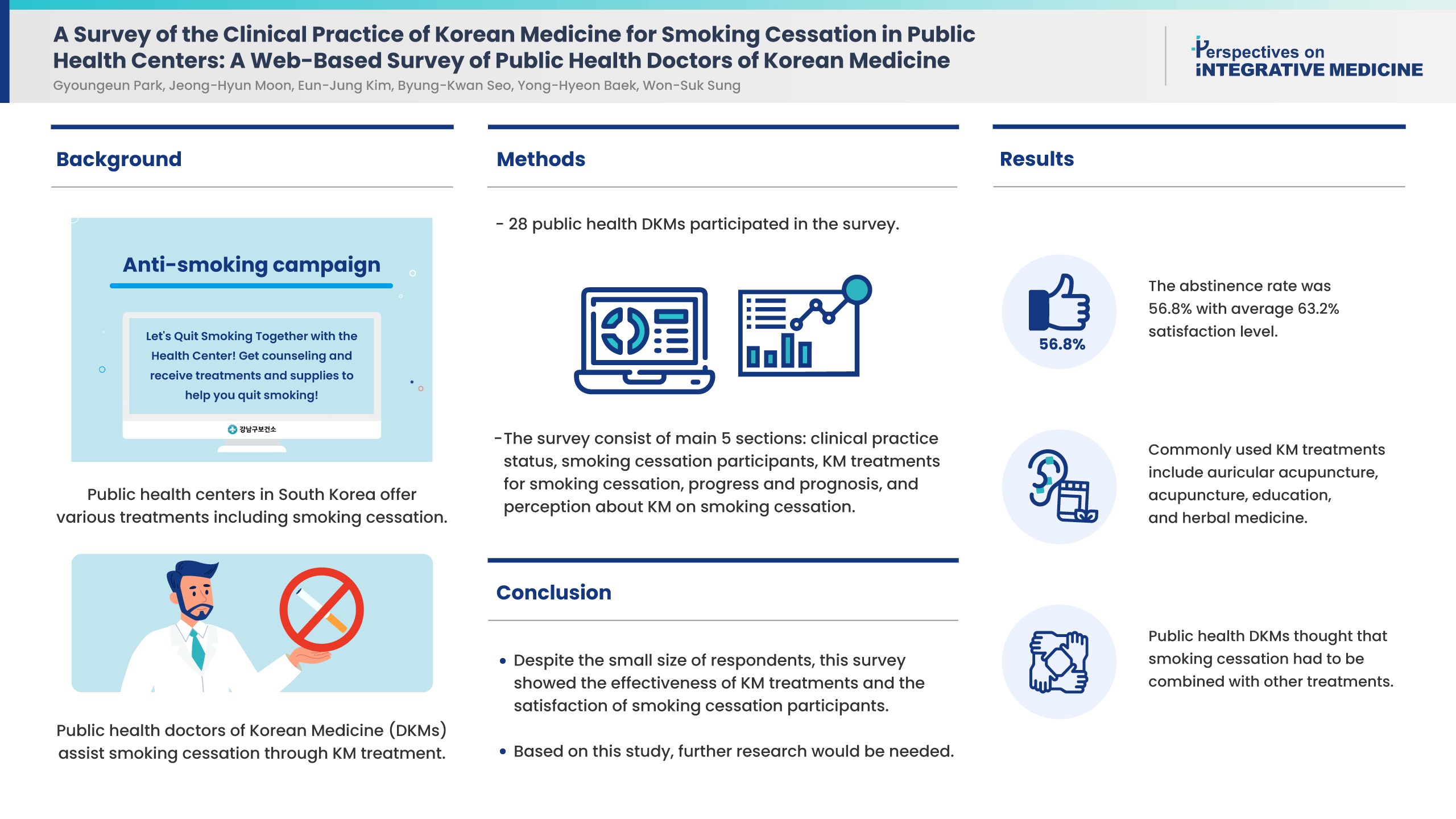
- Background
In South Korea, public health centers provide smoking cessation (SC) treatments including behavioral therapy and nicotine replacement treatment. Also, public health doctors of Korean medicine (PHDKMs) are providing Korean Medicine (KM) treatments. Several studies have reported the clinical usefulness of KM treatment, but in this study, the opinion of PHDKMs was explored to examine the current KM treatments for SC.
Methods
A web-based survey (Moaform) of the treatment for SC by PHDKMs consisted of 5 main sections including clinical practice status, SC participants, KM treatments for SC, progress and prognosis, and perception of KM. The survey was emailed twice to 621 PHDKMs on April 6 to 20, 2022. The frequencies and percentages of each question were calculated.
Results
There were 28 PHDKMs who participated in the survey. Among them, over 90% of PHDKMs had treated ≤ 10 SC participants, and about 10% of PHDKMs had treated 11-20 participants. The abstinence rate was 56.8% with an average 63.2% level of satisfaction in the treatment. Typically used, and recognized as important KM treatments, were auricular acupuncture, acupuncture, education, and herbal medicine. While auricular acupuncture and education were perceived as convenient KM treatment, PHDKMs thought that SC could not be achieved with KM treatment alone and needed be combined with other treatments.
Conclusion
This survey showed the effectiveness of KM treatments with withdrawal symptoms, and treatment satisfaction of SC participants. Respondents also thought that KM treatment combined with other treatments is more effective than KM monotherapy. Based on this small study, further research would be needed.
Review Articles
- Effectiveness and Safety of Low-Level Laser Treatment for Lumbar Disc Herniation: A Systematic Review and Meta-Analysis
- Sang Jun Lee, Seung Jin Noh, Jeong Rock Kim, Kyung Bok Park, Sae-rom Jeon, Yejin Hong, Dongwoo Nam
- Perspect Integr Med. 2023;2(3):155-163. Published online October 23, 2023
- DOI: https://doi.org/10.56986/pim.2023.10.003
- 1,969 View
- 61 Download
-
 Graphical Abstract
Graphical Abstract
 Abstract
Abstract
 PDF
PDF Supplementary Material
Supplementary Material 
- Background
Low-level laser treatment (LLLT) is used to treat low back pain (LBP) however, its effects on lumbar disc herniation (LDH) remain unclear. The safety and effectiveness of LLLT for LDH was determined using a systematic review of randomized clinical trials.
Methods
Studies on LLLT in adults with LDH were identified from 12 worldwide databases. A risk of bias assessment and a meta-analysis with categorization according to the type of control used (inactive, active, or add-on) was performed. The quality of evidence was assessed using the Grading of Recommendations, Assessment, Development, and Evaluation.
Results
The quantitative analyses included five studies. LLLT was significantly more effective at treating LDH [leg pain visual analog scale (VAS) mean difference (MD): -1.90, 95% confidence interval (CI): -2.01, -1.80, I2 80%; LBP VAS MD: -0.79, 95% CI: -0.87, -0.71, I2 80%] than inactive controls (placebo or sham). The quality of the evidence ranged from “low” to “very low.” As an add-on to usual care, LLLT significantly improved pain intensity and disability compared with usual care (leg pain VAS MD: -2.52, 95% CI: -2.65, -2.40, I2 97%; LBP VAS MD: -1.47, 95% CI: -1.58, -1.36; Oswestry Disability Index MD: -4.10, 95% CI: -4.55, -3.65, I2 6%). However, the quality of the evidence ranged from “moderate” to “low.”
Conclusion
LLLT significantly improved outcomes compared with the inactive controls, but was not more effective than usual care for LDH. In combination with usual care, LLLT was significantly more effective than usual care alone highlighting the potential of LLLT.
- A Modern Interpretation of Cold-Heat Pattern in Traditional Medicine with a Focus on Thermo-Regulation
- Younggwang Kim, Jee Young Lee, Joongho Lee, Sanghun Lee
- Perspect Integr Med. 2024;3(1):18-28. Published online February 22, 2024
- DOI: https://doi.org/10.56986/pim.2024.02.003
- 1,084 View
- 22 Download
-
 Graphical Abstract
Graphical Abstract
 Abstract
Abstract
 PDF
PDF Supplementary Material
Supplementary Material 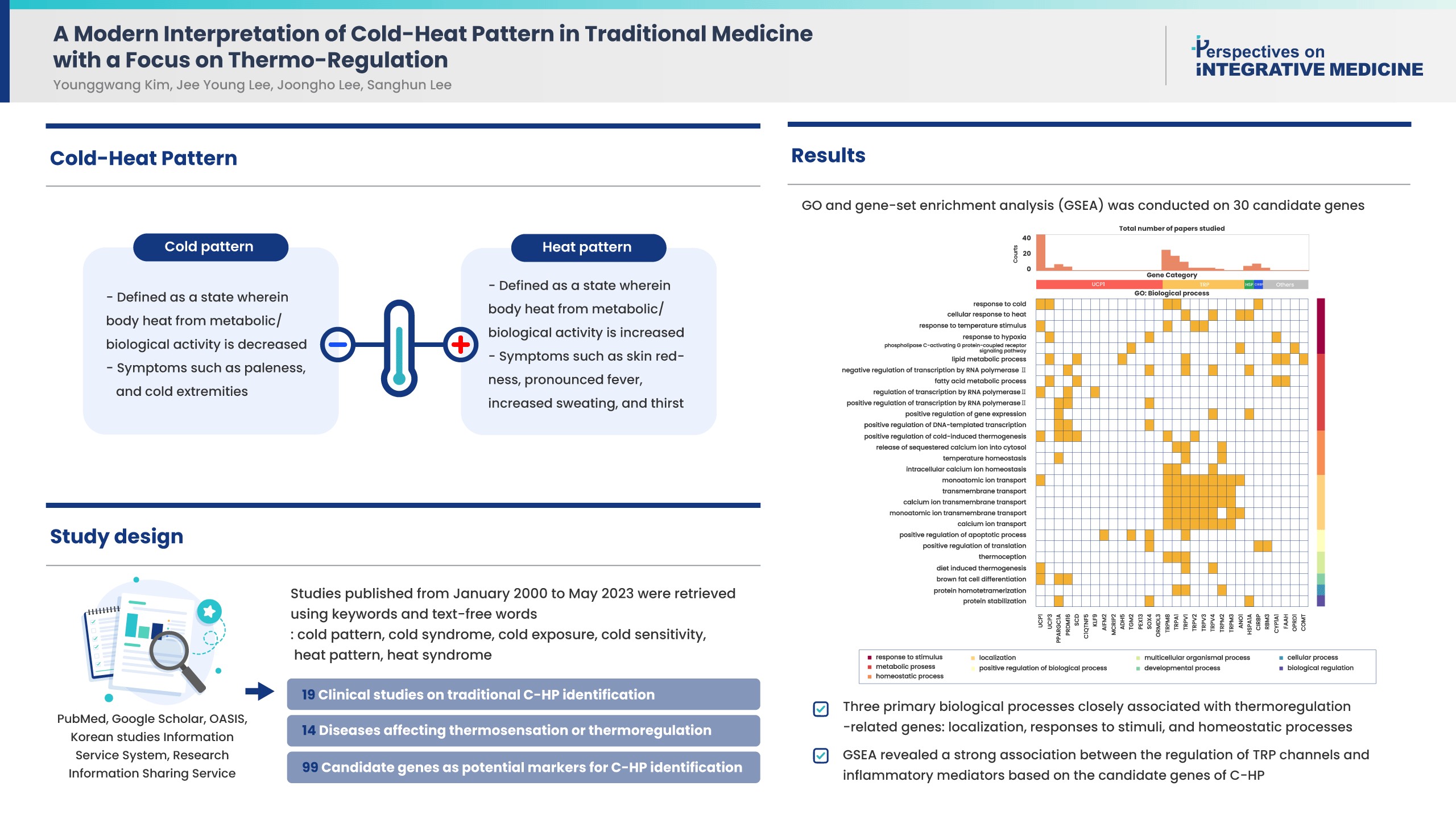
- Cold-heat patterns (C-HPs) in Traditional East Asian Medicine are essential for individually diagnosing and treating patients. However, the concept of C-HPs and their biological mechanisms (thermoregulation) remains unclear. C-HPs studies published between January 2000 and May 2023 were retrieved from 5 databases (PubMed, Google Scholar, OASIS, Korean studies Information Service System, and Research Information Sharing Service). Among the 8,373 articles screened, 132 were included in the review and categorized. Nineteen articles were clinical studies related to traditional concept of C-HP identification, 14 studies investigated diseases affecting thermosensation or thermoregulation, and 99 studies identified candidate genes as potential markers for C-HP identification. Further analysis, including gene ontology, and gene set enrichment analysis of the candidate genes, revealed 3 primary biological processes closely associated with thermoregulation-related genes, including localization, responses to stimuli, and homeostatic processes. Notably there was a significant association between the candidate genes and inflammatory mediator regulation of transient receptor potential channels (p < 0.001). A significant association between C-HPs and inflammation-related pathways across thermosensation-related and thermoregulation-related clinical and preclinical studies was observed, suggesting that the traditional concept of C-HPs should be studied further from an immunological perspective.
Letter
- Treatment Recommendations in Korea for Patients with Axial Spondyloarthritis: The Evidence for Acupuncture Treatment in Axial Spondyloarthritis Patients Should be Re-evaluated
- Tae-Hun Kim, Myeong Soo Lee, Hyangsook Lee, Stephen Birch, Terje Alraek
- Perspect Integr Med. 2024;3(1):61-62. Published online February 22, 2024
- DOI: https://doi.org/10.56986/pim.2024.02.009
- 1,007 View
- 16 Download
Original Article
- Effects of Pulsed Electromagnetic Field Therapy and Photontherapy in Cervicobrachialgia: A Randomized Controlled Trial
- Bianca dos Santos Bobadilha, Talita Bonato de Almeida, Maria Imaculada de Lima Montebello, Maria da Luz Rosário de Sousa
- Perspect Integr Med. 2024;3(1):37-44. Published online February 22, 2024
- DOI: https://doi.org/10.56986/pim.2024.02.005
- 1,066 View
- 19 Download
-
 Graphical Abstract
Graphical Abstract
 Abstract
Abstract
 PDF
PDF 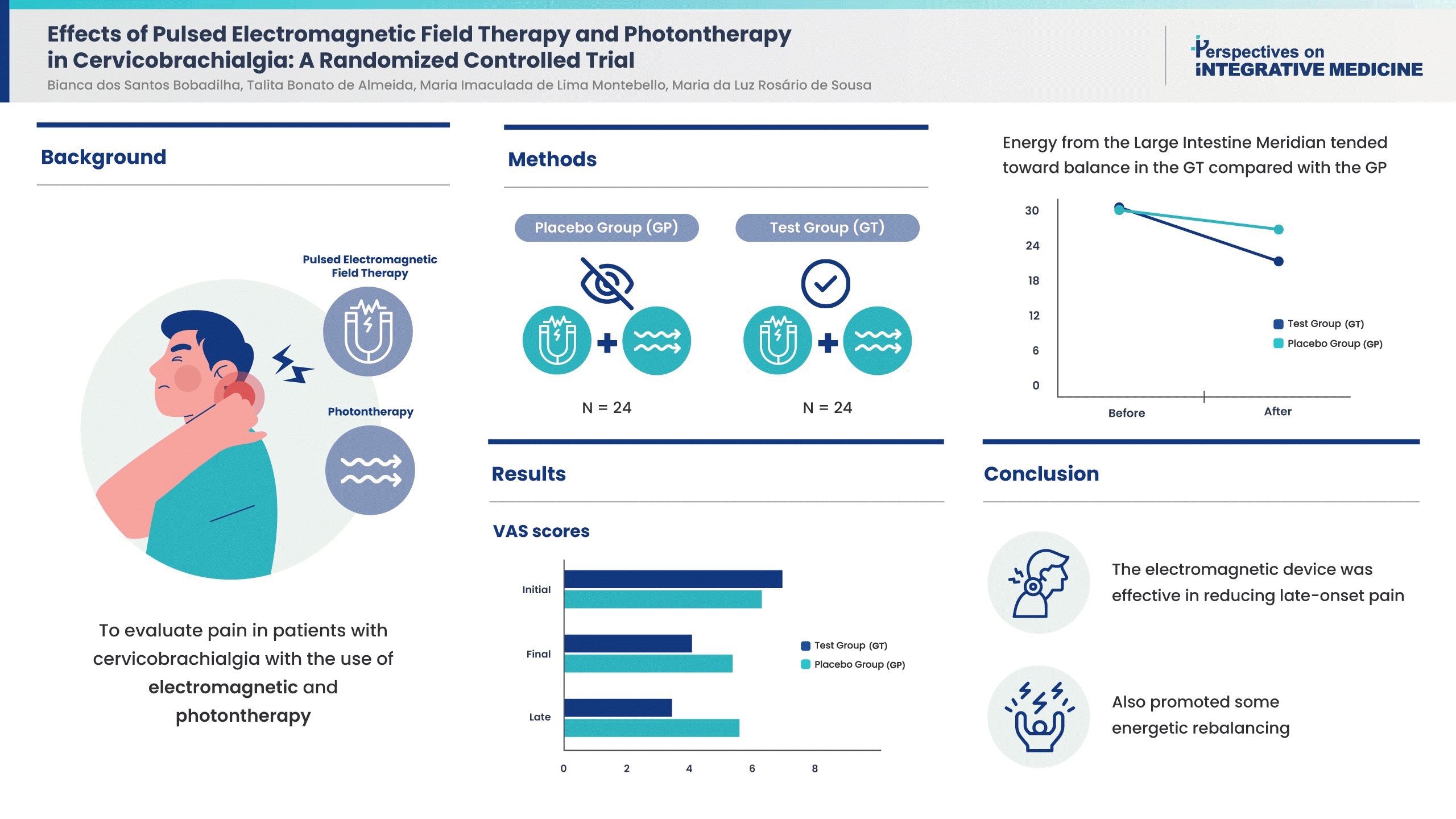
- Background
Cervicobrachialgia is a painful condition commonly treated with medication and physiotherapy. The aim was to evaluate pain following electromagnetic and photontherapy, and examine patient energy profiles.
Methods
There were 48 patients experiencing pain [Visual Analogue Scale (VAS) score ≥ 4] who were not receiving medication and physiotherapy and were randomized into Test Group (GT); electromagnetism using a Kenkobio device (intensity = 0.055 mT/frequency = 60 Hz) and photon therapy; a photon therapy blanket, and Placebo Group (GP); the Kenkobio device was turned off and the blanket was not used. Pain was assessed using the VAS, before, immediately after treatment, and the following day. Algometry was also carried out before and after the treatment to understand the pain threshold at bilateral acupoints GB20 and GB21. The energy profile was assessed using Ryodoraku measurements before and after the session.
Results
The GT achieved a greater reduction in pain the following day than GP. Both groups were equal for left GB20 and right GB21 points considering algometry and, after the intervention, a reduction in pain in the GT was noticed only in the left GB20 (CI [95%]: 0.09-0.99, p = 0.019). The average energy level was low and dropped further following treatment. Furthermore, energy from the Large Intestine Meridian tended towards balance in the GT compared with the GP [CI (95%): 0.58-15.75, p = 0.035]. No adverse effects were reported.
Conclusion
The combined use of electromagnetic and photontherapy were effective in reducing pain in patients and promoted energy rebalancing.



 First
First Prev
Prev


